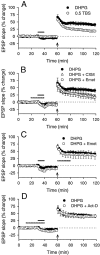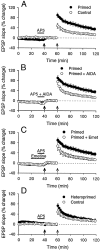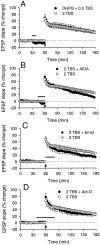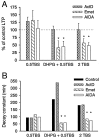Metabotropic glutamate receptors trigger homosynaptic protein synthesis to prolong long-term potentiation
- PMID: 10648701
- PMCID: PMC6774154
- DOI: 10.1523/JNEUROSCI.20-03-00969.2000
Metabotropic glutamate receptors trigger homosynaptic protein synthesis to prolong long-term potentiation
Abstract
We investigated the mechanisms by which previous "priming" activation of group I metabotropic glutamate receptors (mGluRs) facilitates the persistence of long-term potentiation (LTP) in area CA1 of rat hippocampal slices. Priming of LTP was elicited by either pharmacological or synaptic activation of mGluRs before a weak tetanic stimulus that normally produced only a rapidly decaying phase of LTP that did not involve protein synthesis or mGluRs. Pharmacological priming of LTP persistence by a selective group I mGluR agonist was blocked by an inhibitor of group I mGluRs and by inhibitors of translation, but not by a transcriptional inhibitor. The same mGluR agonist increased (35)S-methionine incorporation into slice proteins. LTP could also be facilitated using a synaptic stimulation priming protocol, and this effect was similarly blocked by group I mGluR and protein synthesis inhibitors. Furthermore, using a two-pathway protocol, the synaptic priming of LTP was found to be input-specific. To test for the contribution of group I mGluRs and protein synthesis to LTP in nonprimed slices, a longer duration control tetanization protocol was used to elicit a more slowly decaying form of LTP than did the weak tetanus used in the previous experiments. The persistence of the LTP induced by this stronger tetanus was dependent on mGluR activation and protein synthesis but not on transcription. Together, these results suggest that mGluRs couple to nearby protein synthesis machinery to homosynaptically regulate an intermediate phase of LTP dependent on new proteins made from pre-existing mRNA.
Figures





Similar articles
-
Priming of long-term potentiation induced by activation of metabotropic glutamate receptors coupled to phospholipase C.Hippocampus. 1998;8(2):160-70. doi: 10.1002/(SICI)1098-1063(1998)8:2<160::AID-HIPO8>3.0.CO;2-P. Hippocampus. 1998. PMID: 9572722
-
Evidence for involvement of group II/III metabotropic glutamate receptors in NMDA receptor-independent long-term potentiation in area CA1 of rat hippocampus.J Neurophysiol. 1999 Dec;82(6):2956-69. doi: 10.1152/jn.1999.82.6.2956. J Neurophysiol. 1999. PMID: 10601432
-
Selective induction of metabotropic glutamate receptor 1- and metabotropic glutamate receptor 5-dependent chemical long-term potentiation at oriens/alveus interneuron synapses of mouse hippocampus.Neuroscience. 2008 Jan 2;151(1):28-42. doi: 10.1016/j.neuroscience.2007.09.071. Epub 2007 Oct 11. Neuroscience. 2008. PMID: 18035501
-
Comparing the role of metabotropic glutamate receptors in long-term potentiation and in learning and memory.Prog Neuropsychopharmacol Biol Psychiatry. 1996 Jul;20(5):761-89. doi: 10.1016/0278-5846(96)00058-9. Prog Neuropsychopharmacol Biol Psychiatry. 1996. PMID: 8870063 Review.
-
Metabotropic glutamate receptors: electrophysiological properties and role in plasticity.Brain Res Brain Res Rev. 1999 Jan;29(1):83-120. doi: 10.1016/s0165-0173(98)00050-2. Brain Res Brain Res Rev. 1999. PMID: 9974152 Review.
Cited by
-
Role of mGlu5 in Persistent Forms of Hippocampal Synaptic Plasticity and the Encoding of Spatial Experience.Cells. 2022 Oct 24;11(21):3352. doi: 10.3390/cells11213352. Cells. 2022. PMID: 36359749 Free PMC article. Review.
-
Intracellular astrocyte calcium waves in situ increase the frequency of spontaneous AMPA receptor currents in CA1 pyramidal neurons.J Neurosci. 2004 Jan 21;24(3):722-32. doi: 10.1523/JNEUROSCI.2859-03.2004. J Neurosci. 2004. PMID: 14736858 Free PMC article.
-
Understanding the physical basis of memory: Molecular mechanisms of the engram.J Biol Chem. 2022 May;298(5):101866. doi: 10.1016/j.jbc.2022.101866. Epub 2022 Mar 26. J Biol Chem. 2022. PMID: 35346687 Free PMC article. Review.
-
Time-restricted role for dendritic activation of the mTOR-p70S6K pathway in the induction of late-phase long-term potentiation in the CA1.Proc Natl Acad Sci U S A. 2003 Nov 25;100(24):14368-73. doi: 10.1073/pnas.2336098100. Epub 2003 Nov 17. Proc Natl Acad Sci U S A. 2003. PMID: 14623952 Free PMC article.
-
Extracellular signal-regulated kinase 1/2 is required for the induction of group I metabotropic glutamate receptor-mediated epileptiform discharges.J Neurosci. 2004 Jan 7;24(1):76-84. doi: 10.1523/JNEUROSCI.4515-03.2004. J Neurosci. 2004. PMID: 14715940 Free PMC article.
References
-
- Abraham WC, Bear MF. Metaplasticity: the plasticity of synaptic plasticity. Trends Neurosci. 1996;19:126–130. - PubMed
-
- Abraham WC, Otani S. Macromolecules and the maintenance of long-term potentiation. In: Morrell F, editor. Kindling and synaptic plasticity. The legacy of Graham Goddard. Birkhauser; Boston: 1991. pp. 92–109.
-
- Abraham WC, Tate WP. Metaplasticity: a new vista across the field of synaptic plasticity. Prog Neurobiol. 1997;52:303–323. - PubMed
-
- Abraham WC, Demmer J, Richardson C, Williams J, Lawlor P, Mason SE, Tate WP, Dragunow M. Correlations between immediate early gene induction and the persistence of long-term potentiation. Neuroscience. 1993;56:717–727. - PubMed
-
- Bashir ZI, Bortolotto ZA, Davies CH, Berretta N, Irving A, Seal AJ, Henley JM, Jane DE, Watkins JC, Collingridge GA. Induction of LTP in the hippocampus needs synaptic activation of glutamate metabotropic receptors. Nature. 1993;363:347–350. - PubMed
Publication types
MeSH terms
Substances
LinkOut - more resources
Full Text Sources
Other Literature Sources
Miscellaneous
